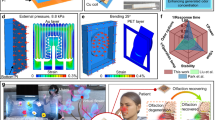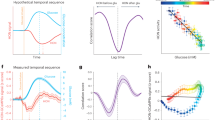Abstract
OBJECTIVE: To determine the influence of caregiving on preterm infant and incubator temperature and to investigate incubator control mode in thermal responses to caregiving.
STUDY DESIGN: The intensive within-subject design involved continuous recording of infant and incubator temperature and videotaping throughout a 24-hour period in 40 hospitalized preterm infants. Temperature at care onset was compared with care offset, and 5, 10, 15, and 20 minutes following care offset using ANOVA-RM.
RESULTS: Following caregiving, infant and incubator temperature differed significantly over time by incubator control mode. In air servo-control, infant temperature tended to decrease after caregiving, while in skin servo-control infant temperature remained relatively stable. With caregiving, incubator temperature remained consistent in air servo-control and increased in skin servo-control.
CONCLUSIONS: The temperature effects of caregiving should be considered relative to maintenance of thermoneutrality and unintentional thermal stimulation.
This is a preview of subscription content, access via your institution
Access options
Subscribe to this journal
Receive 12 print issues and online access
$259.00 per year
only $21.58 per issue
Buy this article
- Purchase on Springer Link
- Instant access to full article PDF
Prices may be subject to local taxes which are calculated during checkout

Similar content being viewed by others
References
Narendran V, Hoath SB . Thermal management of the low birth weight infant: a cornerstone of neonatology. J Pediatr 1999;134(5):529–531.
Apedoh A, el Hajajji A, Telliez F, Bouferrache B, Libert JP, Rachid A . Mannequin-assessed dry-heat exchanges in the incubator-nursed newborn. Biomed Instrum Technol 1999;33(5):446–454.
Graven SN, Bowen FW, Brooten D, et al. The high-risk infant environment. Part 1. The role of the neonatal intensive care unit in the outcome of high-risk infants. J Perinatol 1992;12(2):164–172.
Dollberg S, Demarini S, Donovan EF, Hoath SB . Maturation of thermal capabilities in preterm infants. Am J Perinatol 2000;17(1):47–51.
Richardson DK, Shah BL, Frantz ID, Bednarek F, Rubin LP, McCormick MC . Perinatal risk and severity of illness in newborns at 6 neonatal intensive care units. Am J Med Sci 1999;89(4):511–516.
Thomas KA, Burr R . Preterm infant thermal care: differing thermal environments produced by air versus skin servo-control incubators. J Perinatol 1999;19(4):264–270.
Dollberg S, Atherton HD, Hoath SB . Effect of different phototherapy lights on incubator characterisitcs and dynamics under three modes of servocontrol. Am J Perinatol 1995;12(1):55–60.
Bach V, Telliez F, Zoccoli G, Lenzi P, Leke A, Libert JP . Interindividual differences in the thermoregulatory response to cool exposure in sleeping neonates. Eur J Appl Physiol 2000;81(6):455–462.
Omar SY, Greisen G, Ibrahim MM, Youssef AM, Friis-Hansen B . Blood pressure reponses to care procedures in ventilated preterm infants. Acta Pædiatr Scand 1985;74:920–924.
Brandon DH, Holditch-Davis D, Beylea M . Nursing care and the development of sleeping and waking behaviors in preterm infants. Res Nurs Health 1999;22(3):217–229.
Evans JC . Incidence of hypoxemia associated with caregiving in premature infants. Neonatal Netw 1991;10(2):17–24.
Evans JC, Vogelpohl DG, Bourguignon CM, Morcott CS . Pain behaviors in LBW infants accompany some “nonpainful” caregiving procedures. Neonatal Netw 1997;16(3):33–40.
Gorski PA, Huntington L, Lewkowicz DJ . Handling preterm infants in hospitals. Stimulating controversy about timing of stimulation. Clin Perinatol 1990;17(1):103–112.
Ingersoll EW, Thoman EB . Sleep/wake states of preterm infants: stability, developmental change, diurnal variation, and relation with caregiving activity. Child Dev 1999;70(1):1–10.
Zahr LK, Balian S . Responses of premature infants to routine nursing interventions and noise in the NICU. Nurs Res 1995;44(3):179–185.
Duxbury ML, Henly SJ, Broz LJ, Armstrong GD, Wachdorf CM . Caregiver disruptions and sleep of high-risk infants. Heart Lung 1984; 13:141–147.
Evans JC . Patterns of caregiving for premature infants. Neonatal Netw 1992;11(1):62.
Bueno C, Diambra L, Menna-Barreto L . Sleep–wake and temperature rhythms in preterm babies maintained in a neonatal care unit. Sleep Res Online 2001;4(3):77–82.
Mok Q, Bass CA, Ducker DA, McIntosh N . Temperature instability during nursing procedures in preterm neonates. Arch Dis Child 1991;66:783–786.
Horns KM . Comparison of two microenvironments and nurse caregiving on thermal stability of ELBW infants. Adv Neonatal Care 2002;2(3):149–160.
Shefi O, Davidson S, Maayan A, Akselrod S . The effect of thermal stimulation on the heart-rate variability in neonates. Early Hum Dev 1998;52(1):49–66.
Bach V, Telliez F, Zoccoli G, Lenzi P, Leke A, Libert JP . Interindividual differences in the thermoregulatory response to cool exposure in sleeping neonates. Eur J Appl Physiol 2000;81(6):455–462.
Mayfield SR, Bhatia J, Nakamura KT, Rios GR, Bell EF . Temperature measurement in term and preterm neonates. J Pediatr 1984; 104(2):271–275.
Bell EF, Rios GR . Air versus skin temperature servocontrol of infant incubators. J Pediatr 1983;103(6):954–959.
Sjors G, Hammarlund K, Kjartansson S, Riesenfeld T, Sedin G . Respiratory water loss and oxygen consumption in full-term infants exposed to cold air on the first day after birth. Acta Pædiatr 1994;83(8):802–807.
Telliez F, Bach V, Delanaud S, Leke A, Abdiche M, Chardon K . Influence of incubator humidity on sleep and behaviour of neonates kept at stable body temperature. Acta Pædiatr 2001;90(9):998–1003.
Berterottiere D, D'Allest AM, Dehan M, Gaultier C . Effects of increase in body temperature on the breathing pattern in premature infants. J Dev Physiol 1990;13(6):303–308.
Sinclair JC . Servo-control for maintaining abdominal skin temperature at 36°C in low birth weight infants. Cochrane Database Syst Rev 2000;(2):CD001074.
Author information
Authors and Affiliations
Additional information
Research supported by a grant awarded from the National Center for Nursing Research, R29 NR02420.
Statistical consultant: Robert Burr, PhD, MSEE, Department of Biobehavioral Nursing and Health Systems, University of Washington.
Rights and permissions
About this article
Cite this article
Thomas, K. Preterm Infant Thermal Responses to Caregiving Differ by Incubator Control Mode. J Perinatol 23, 640–645 (2003). https://doi.org/10.1038/sj.jp.7211002
Published:
Issue Date:
DOI: https://doi.org/10.1038/sj.jp.7211002
This article is cited by
-
Extremely low birth weight preterm infants lack vasomotor response in relationship to cold body temperatures at birth
Journal of Perinatology (2009)
-
Toward a Fuzzy Logic Control of the Infant Incubator
Annals of Biomedical Engineering (2009)



